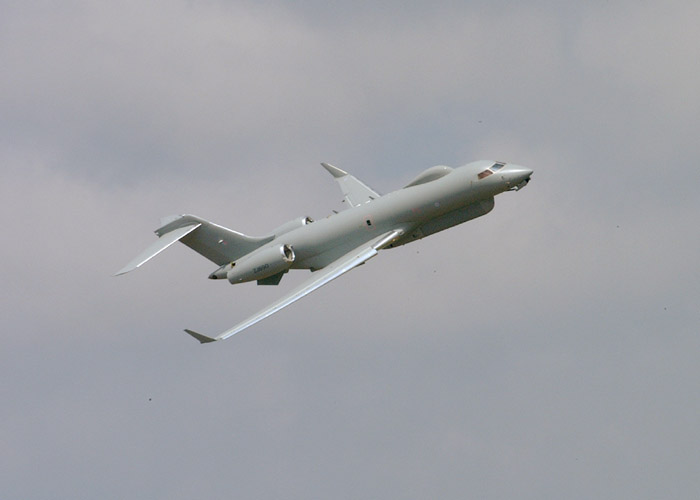- Raytheon Sentinel
infobox Aircraft
name = Sentinel
caption = Sentinel R.1 ZJ690
type = Airborne battlefield and ground surveillance
manufacturer =Raytheon
designer =
first flight = 26 May 2004
introduced = 2005
retired =
produced =
primary user =Royal Air Force
more users =
number built = 5
status = Operational
unit cost =
developed from =Bombardier Global Express
variants with their own articles =The
Raytheon Sentinel is under development as the RAF's ASTOR (Airborne STand-Off Radar) aircraft. Based on theBombardier Global Express , it will be a dedicated RAF asset albeit with the squadron having joint manning with theBritish Army , providing battlefield and ground surveillance in a similar role to the American E-8JSTARS aircraft. ASTOR will be totally interoperable with allied systems such as JSTARS and the NATOAlliance Ground Surveillance (AGS) system.Design and development
The radar is installed on a heavily modified
Bombardier Global Express , which will be known as the Sentinel R1 in RAF service. The aircraft is powered by the same engines used in the Nimrod MRA4 upgrade programme, the Rolls-Royce BR710. The first flight of the prototype, a modified Global Express airframe, was in August 2001, which validated the modifications required for the ASTOR system. The first production Sentinel R1 made its 4.4 hour maiden flight on 26 May 2004. The initial operating capability will be achieved in 2008. The aircraft is based atRAF Waddington and operated by 5 Sqn.The original contracts call for a total of five aircraft, eight mobile ground stations (six on wheeled all terrain vehicles and two in air transportable containers), and extensive training facilities at the main RAF station.
The ASTOR cockpit features a new centrally housed, pull-down screen capable of displaying a moving map,
Link 16 datalink information and defensive aids subsystem (DASS) data.The DASS comprises a towed radar decoy, missile approach warning system and chaff and flare dispensers and can be operated in automatic, semi-automatic or manual mode.The aircraft will normally fly at over 15,000 m (40,000 ft) to ensure a high resolution view of a large battlefield area. It will be crewed by a pilot, a co-pilot, an Airborne Mission Commander (AMC) and 2 image analysts. Mission endurance should be about 9 hours. While the image analysts can analyse the images on board the aircraft it is expected that, unlike the JSTARS, the actual
battle management will occur on the ground.The
radar which provides this capability is supplied by Raytheon Systems Ltd. (RSL), the UK subsidiary ofRaytheon . It is a next-generation dual-modeSynthetic Aperture /Moving Target Indication (SAR/MTI) radar based on proven technology previously used in Raytheon’sASARS-2 system.While suffering from delays the project is one of few procurement projects to be below cost estimates.Fact|date=September 2008
pecifications
*Length: 99 ft 5 in (30.31m)
*Wingspan: 93 ft 6 in (28.51m)
*Height: 27 ft (8.23m)
*Wing area: 1022 ft2 (95m2
*Empty weight: 54,000 lb (24,500kg)
*Maximum Ramp Weight: 93,750 lbs (42524kg)
*Maximum Gross Takeoff Weight: 93,500 lbs (42411kg)
*Maximum Landing Weight: 78,600 lbs (35652kg)
*Maximum Zero Fuel Weight: 56,000 lbs (25401kg)
*Engine: 2 BMW Rolls-Royce BR710 @ 14,750 lbst
*Maximum speed: Mach 0.89
*Cruising speed: Mach 0.80
*Range: 6,500 nm
*Service Ceiling: 51,000 ft
*Armament: noneee also
aircontent
related=
*Bombardier Global Express
similar aircraft=
*E-8 Joint STARS
lists =
*List of aircraft of the Royal Air Force
see also=
*Airborne Warning and Control System (AWACS)References
* Winchester, Jim. "Aircraft of the RAF Part 5 - Raytheon Sentinel R1". "
Air International ", Volume 75 No.3, September 2008. pp.54-57.External links
* [http://www.raytheon.co.uk/products/astor/index.html Raytheon: ASTOR]
* [http://www.raytheon.com/feature/stellent/groups/public/documents/content/cms04_018168.pdf ASTOR is born]
Wikimedia Foundation. 2010.
